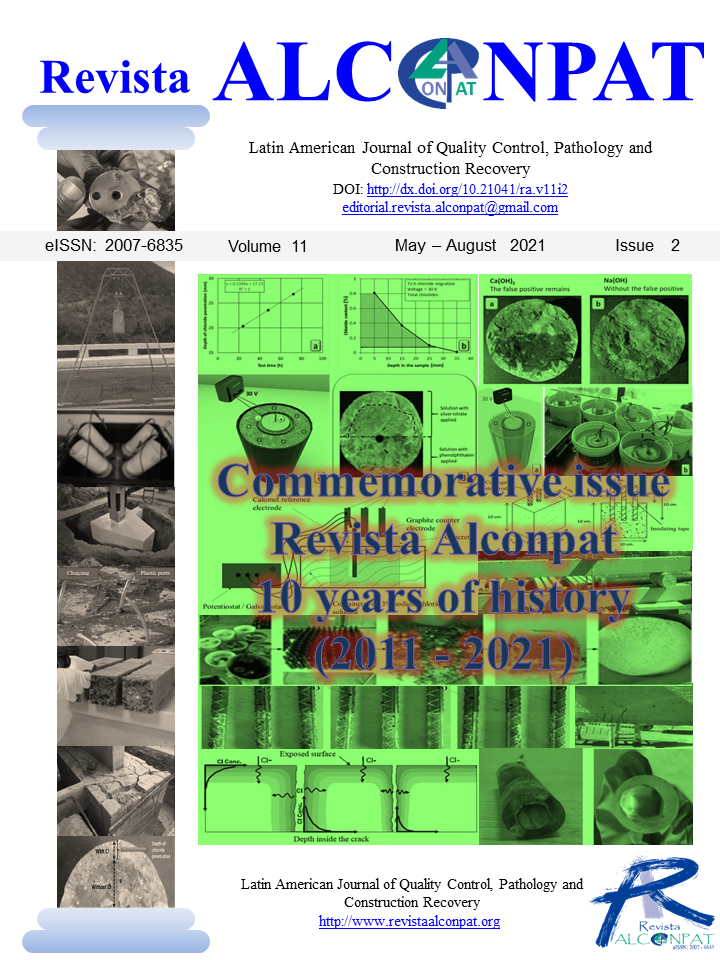Procedure to detect the penetration of chlorides into carbonated concrete with silver nitrate
DOI:
https://doi.org/10.21041/ra.v11i2.480Keywords:
durability of concrete, chloride attack, silver nitrate, carbonation, environmental aggressivenessAbstract
The main objective of this work is to propose a standard procedure that enables the use of the colorimetric method to measure the depth of chloride penetration during inspections of concrete structures exposed to both chlorides and carbonation. To avoid the occurrence of false positive results, solutions of calcium hydroxide (Ca(OH)2) and sodium hydroxide (NaOH) were tested as a pretreatment. The tests were carried out on carbonated only samples, and on carbonate and chloride contaminated samples. The results show that the NaOH solution eliminates the carbonation interference. Therefore, a suitable method was found to introduce depth readings of chloride contamination in concrete field inspections.
Downloads
References
ASTM International. (2020). ASTM C1152/C1152M-20 Standard Test Method for Acid-Soluble Chloride in Mortar and Concrete. https://doi.org/10.1520/C1152_C1152M-20
Azarijafari, H., Azarijafari H., Tajadini, A., Rahimi, M., Berenjian, J. (2018), Reducing variations in the test results of self-consolidating lightweight concrete by incorporating pozzolanic materials. Construction and Building Materials. 166: 889-897. https://doi.org/10.1016/j.conbuildmat.2018.01.121
Baroghel-Bouny, V., Belin, P., Maultzsch, M., Henry, D. (2007), AgNO3 spray tests: advantages, weaknesses, and various applications to quantify chloride ingress into concrete. Part 1: Non-steady-state diffusion tests and exposure to natural conditions. Materials and Structures. 40: 759-781. https://doi.org/10.1617/s11527-007-9233-1
Cascudo, O. (1997), "Controle da Corrosão de Armaduras em concreto: inspeções e técnicas eletroquímicas". PINI, 1.ed., São Paulo, Brasil.
Corral, R., Arredondo, S., Almaral, J., & Gómez, J. (2013). Chloride corrosion of embedded reinforced steel on concrete elaborated from recycled coarse aggregates and supplementary cement materials. Revista Ingeniería de Construcción, 28(1): 21-35. http://dx.doi.org/10.4067/S0718-50732013000100002
Fernández-Ruiz, M. A., Gil-Martín, L. M., Carbonell-Márquez, J. F., Hernández-Montes, E. (2018), Epoxy resin and ground tyre rubber replacement for cement in concrete: Compressive behaviour and durability properties. Construction and Building Materials. 173: 49-57. https://doi.org/10.1016/j.conbuildmat.2018.04.004
Ferreira, R. M., Castro-Gomes, J. P., Costa, P., & Malheiro, R. (2016). Effect of metakaolin on the chloride ingress properties of concrete. KSCE Journal of Civil Engineering, 20(4), 1375-1384. https://doi.org/10.1007/s12205-015-0131-8
França, C. B. (2011), "Avaliação de cloretos livres em concretos e argamassas de cimento Portland pelo método de aspersão de solução de nitrato de prata". Dissertação de Mestrado, Programa de Pós-graduação em Engenharia Civil, Universidade Católica de Pernambuco, Recife, 85 p.
He, F., Shi, C., Yuan, Q., Chen, C., Zheng, K. (2012), AgNO3-based colorimetric methods for measurement of chloride penetration in concrete. Construction and Building Materials. 26: 1-8. https://doi.org/10.1016/j.conbuildmat.2011.06.003
He, F., Shi, C., Yuan, Q., An, X., Tong, B. (2018), Corrosion of cement pastes made of CEM I and CEM III/A caused by a saturated water solution of ammonium chloride after 4 and 25 days of aggressive immersion. Construction and Building Materials. 170: 279–289. https://doi.org/10.1016/j.conbuildmat.2018.03.073
Helene, P. (1993), "Contribuição ao estudo da corrosão em armaduras de concreto armado". Tese de Livre Docência, Escola Politécnica, Universidade de São Paulo, São Paulo, 231 p.
Kim, M-Y., Yang, E-I., Yi, S-T. (2013), Application of the colorimetric method to chloride diffusion evaluation in concrete structures. Construction and Building Materials. 41: 239-245. https://doi.org/10.1016/j.conbuildmat.2012.11.084
Lau, P. C., Teo, D. C. L., Mannan, M. A. (2018). Mechanical, durability and microstructure properties of lightweight concrete using aggregate made from lime-treated sewage sludge and palm oil fuel ash. Construction and Building Materials. 176: 24-34. https://doi.org/10.1016/j.conbuildmat.2018.04.179
Medeiros, M. H. F. (2008), "Contribuição ao estudo da durabilidade de concretos com proteção superficial frente à ação de íons cloretos". Tese de Doutorado, Universidade de São Paulo, São Paulo.
Medeiros, M. H. F., Hoppe Filho, J., Helene, P. (2009a), Influence of the slice position on chloride migration tests for concrete in marine conditions. Marine Structures. 22: 128-141. https://doi.org/10.1016/j.marstruc.2008.09.003
Medeiros, M. H. F., Helene, P. (2009b), Surface treatment of reinforced concrete in marine environment: Influence on chloride diffusion coefficient and capillary water absorption. Construction and building materials. 23(3): 1476-1484. https://doi.org/10.1016/j.conbuildmat.2008.06.01
Medeiros, M. H. F., Gobbi, A., Réus, G. C., Helene, P. (2013), Reinforced concrete in marine environment: Effect of wetting and drying cycles, height and positioning in relation to the sea shore. Construction and Building Materials. 44: 452-457. https://doi.org/10.1016/j.conbuildmat.2013.02.078
Medeiros Junior, R. A., Lima, M. G., Brito, P. C., Medeiros, M. H. F. (2015a), Chloride penetration into concrete in an offshore platform-analysis of exposure conditions. Ocean Engineering. 103: 78-87. https://doi.org/10.1016/j.oceaneng.2015.04.079
Medeiros-Junior, R. A., Lima, M. G., Yazigi, R., Medeiros, M. H. F. (2015b), Carbonation depth in 57 years old concrete structures. Steel and Composite Structures. 19(4): 953-966. https://doi.org/10.12989/scs.2015.19.4.953
Medeiros, M. H. F. D., Raisdorfer, J. W., & Hoppe Filho, J. (2017). Influência da sílica ativa e do metacaulim na velocidade de carbonatação do concreto: relação com resistência, absorção e relação a/c. Ambiente Construído, 17(4), 125-139. https://doi.org/10.1590/s1678-86212017000400189
Medeiros, M. H. F., Réus, G. C., Pontes, C. V. (2018), "Nitrato de prata como método colorimétrico para detecção da penetração de cloretos: análise crítica". in: 3° Simpósio Paranaense de Patologia das Construções, 2018, Curitiba., v. único. pp. 35-46. https://doi.org/10.4322/2526-7248.017
Montemor, M. F., Simões, A. M. P., Ferreira, M. G. S. (2003), Chloride-induced corrosion on reinforcing steel: from the fundamentals to the monitoring techniques. Cement and Concrete Composites. 25: 491-502. https://doi.org/10.1016/S0958-9465(02)00089-6
Moreira, C. (2006), "Realcalinização de estruturas de concreto carbonatado com utilização de gel saturado de solução alcalina". Dissertação de Mestrado, Escola de Engenharia Civil, Universidade Federal de Goiás, Goiânia, 122 p.
Pauletti, C. (2004), "Análise comparativa de procedimentos para ensaios acelerados de carbonatação". Dissertação de Mestrado, Universidade Federal do Rio Grande do Sul, Porto Alegre, 176 p.
Pontes, C. V., Réus, G. C., Araújo, E. C., Medeiros, M. H. F. (2020), Silver nitrate colorimetric method to detect chloride penetration in carbonated concrete: how to prevent false positives. Journal of Building Engineering. https://doi.org/10.1016/j.jobe.2020.101860
Real, L. V., Oliveira, D. R. B., Soares, T., Medeiros, M. H. F. (2015), Método colorimétrico por aspersão de nitrato de prata para avaliação da penetração de cloretos em concreto: estado da arte. Revista Alconpat. 5(2): 149-159. https://doi.org/10.21041/ra.v5i2.84
Réus, G. C. (2017), "Realcalinização química como meio de recuperação de estruturas de concreto armado carbonatadas". Dissertação de Mestrado, Pós-graduação em Engenharia de Construção Civil, Universidade Federal do Paraná, Curitiba, 104 p.
Réus, G. C., Medeiros, M. H. F. (2020), Chemical realkalization for carbonated concrete treatment: Alkaline solutions and application methods. Construction and Building Materials, 262, 120880. https://doi.org/10.1016/j.conbuildmat.2020.120880
RILEM. TC 178-TMC - Testing and modelling chloride penetration in concrete. Madrid: Elsevier; 2013. p. 3.
Vennesland, Ø., Climent, M. Á., Andrade, C. (2013). Recommendation of RILEM TC 178-TMC: Testing and modelling chloride penetration in concrete. Materials and Structures. 46: 337-344. https://doi.org/10.1617/s11527-012-9968-1
Slonka-Slupik, B., Podwórny, J., Staszuk, M. (2018), Corrosion of cement pastes made of CEM I and CEM III/A caused by a saturated water solution of ammonium chloride after 4 and 25 days of aggressive immersion. Construction and Building Materials. 170: 279-289. https://doi.org/10.1016/j.conbuildmat.2018.03.073
Yuan, Q., Shi, C., He, F., Schutter, G. D., Audenaert, K., Zheng, K. (2008), Effect of hydroxyl ions on chloride penetration depth measurement using the colorimetric method. Cement and Concrete Research. 38: 1177-1180. https://doi.org/10.1016/j.cemconres.2008.04.003
Wei, Y., Guo, W., Liang, S. (2018), Chloride Ingress in Internally Cured Concrete under Complex Solution. Journal of Materials in Civil Engineering. 30(4) p. 04018037. https://doi.org/10.1061/(ASCE)MT.1943-5533.0002215
Weiss, J., Couch, J., Pease, B., Laugesen, P., Geiker, M. (2017), Influence of Mechanically Induced Cracking on Chloride Ingress in Concrete. Journal of Materials in Civil Engineering 29(9): 04017128. https://doi.org/10.1061/(ASCE)MT.1943-5533.0001922
Downloads
Published
How to Cite
Issue
Section
License
_______________________________
License in effect from September 2020
You are free to:
- Share — copy and redistribute the material in any medium or format for any purpose, even commercially.
- Adapt — remix, transform, and build upon the material for any purpose, even commercially.
- The licensor cannot revoke these freedoms as long as you follow the license terms.
Under the following terms:
- Attribution — You must give appropriate credit , provide a link to the license, and indicate if changes were made . You may do so in any reasonable manner, but not in any way that suggests the licensor endorses you or your use.
- No additional restrictions — You may not apply legal terms or technological measures that legally restrict others from doing anything the license permits.
Notices:
You do not have to comply with the license for elements of the material in the public domain or where your use is permitted by an applicable exception or limitation .
No warranties are given. The license may not give you all of the permissions necessary for your intended use. For example, other rights such as publicity, privacy, or moral rights may limit how you use the material.





















.png)














